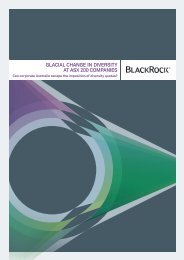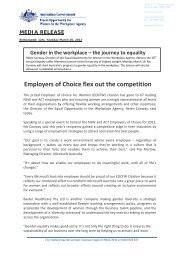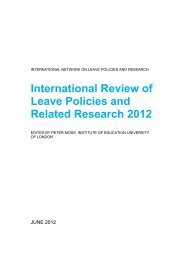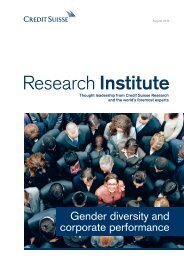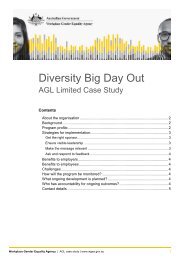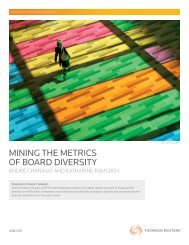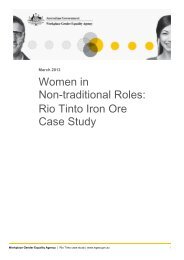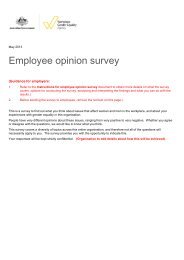Women in NSW 2012 - The Workplace Gender Equality Agency
Women in NSW 2012 - The Workplace Gender Equality Agency
Women in NSW 2012 - The Workplace Gender Equality Agency
Create successful ePaper yourself
Turn your PDF publications into a flip-book with our unique Google optimized e-Paper software.
1.3 Work-related <strong>in</strong>juries and diseasesCompensable <strong>in</strong>juries and disease – major claimsCurrent position<strong>The</strong> direction of changeover timeDiscussion<strong>NSW</strong> women have a lower frequency of compensable <strong>in</strong>juries and diseasesthan men (6.6 claims per million hours worked by women employees,compared to 8.9 claims per million hours worked by men).However, women have a higher rate of mental disorder claims, with afrequency of 0.7 per million hours worked by women employees comparedto 0.4 claims per million hours worked by men. Mental disorder claims madeup over one-quarter of all occupational disease claims <strong>in</strong> 2010.<strong>Gender</strong> gaps:• <strong>The</strong> pattern of work <strong>in</strong>juries demonstrates an overall gender gap <strong>in</strong>women’s favour of 2.3 claims per million hours worked.• Female employees had 0.3 per million hours more mental disorder claimsthan men <strong>in</strong> 2010 (1,545 <strong>in</strong> total).<strong>The</strong> frequency of work-related <strong>in</strong>juries has decl<strong>in</strong>ed dur<strong>in</strong>g the last decadefor both <strong>NSW</strong> women and men, with the decl<strong>in</strong>e greater for men from ahigher start<strong>in</strong>g po<strong>in</strong>t. <strong>The</strong> total number of men’s claims went from 38,000to 27,600 <strong>in</strong> the period 2001 to 2010, while the total number of claims bywomen went from nearly 16,000 to nearly 14,000 <strong>in</strong> the same period.<strong>The</strong> trend <strong>in</strong> occupational disease claims is weaker and women’s lengthof time off work rema<strong>in</strong>s greater than men’s on average (see Table 2.1on page 18).<strong>The</strong> <strong>in</strong>cidence of mental disorder claims peaked <strong>in</strong> the early 2000s,but rema<strong>in</strong>s higher <strong>in</strong> 2010 than <strong>in</strong> 2001 for both women and men.In 2004 the Productivity Commission estimated that the total economiccost of work-related <strong>in</strong>jury and disease <strong>in</strong> Australia was <strong>in</strong> excess of$31 billion annually 13 , <strong>in</strong> addition to the significant non-economic costs borneby <strong>in</strong>dividuals, their families, bus<strong>in</strong>esses and the community as a whole.<strong>Women</strong> and men typically work <strong>in</strong> different <strong>in</strong>dustries and/or occupations<strong>in</strong> <strong>NSW</strong>, each with their own health and safety risks. <strong>Women</strong> are underrepresented<strong>in</strong> some hazardous <strong>in</strong>dustries with high <strong>in</strong>jury and disease rates,such as m<strong>in</strong><strong>in</strong>g and construction, but over-represented <strong>in</strong> <strong>in</strong>dustries such ashealth and education with high <strong>in</strong>terpersonal demands (see Chapter Five).Work-related <strong>in</strong>juries and diseases <strong>in</strong>clude those that result from <strong>in</strong>cidents at the place of work; while commut<strong>in</strong>gto and from work; and illnesses contracted due to work, for example, <strong>in</strong>dustrial deafness, repetitive stra<strong>in</strong> <strong>in</strong>juries,asthma and sk<strong>in</strong> diseases.<strong>The</strong> data above refer to major claims where a workers’ compensation claim was accepted and where five or moredays time off work was paid through the <strong>NSW</strong> workers’ compensation system for <strong>in</strong>capacity aris<strong>in</strong>g from the <strong>in</strong>jury ordisease. <strong>The</strong>se claims amount to approximately 60 percent of annual lost time <strong>in</strong>juries <strong>in</strong> <strong>NSW</strong>.Year collected: 2009-10.Data source: WorkCover <strong>NSW</strong>, Statistical Bullet<strong>in</strong>, 2009-2010, unpublished at the time of writ<strong>in</strong>g.More <strong>in</strong>formation is available at www.workcover.nsw.gov.au13 Productivity Commission (2004) National workers’ compensation and occupational health and safety frameworks, Productivity Commission Inquiry Report no. 27, p xxii.WOMEN IN <strong>NSW</strong> <strong>2012</strong> | HEALTH AND WELLBEING17



